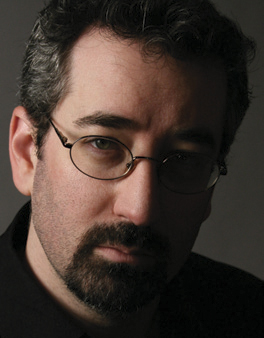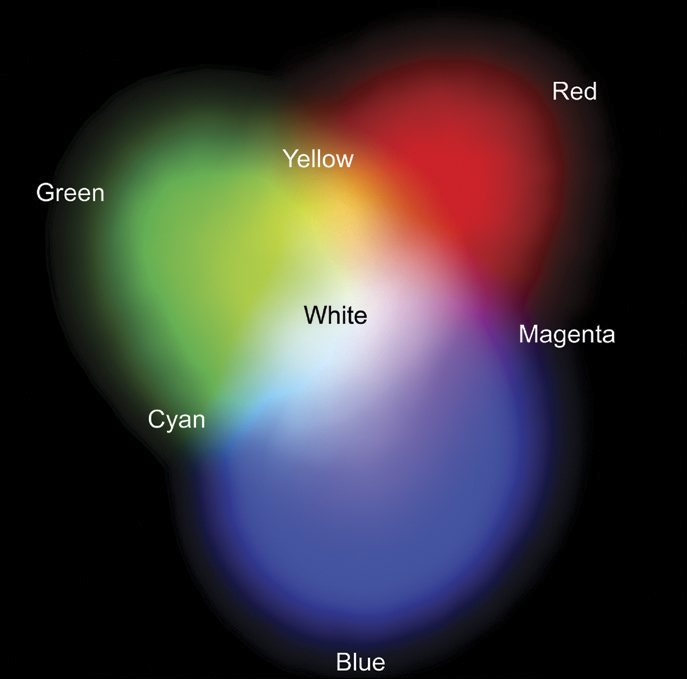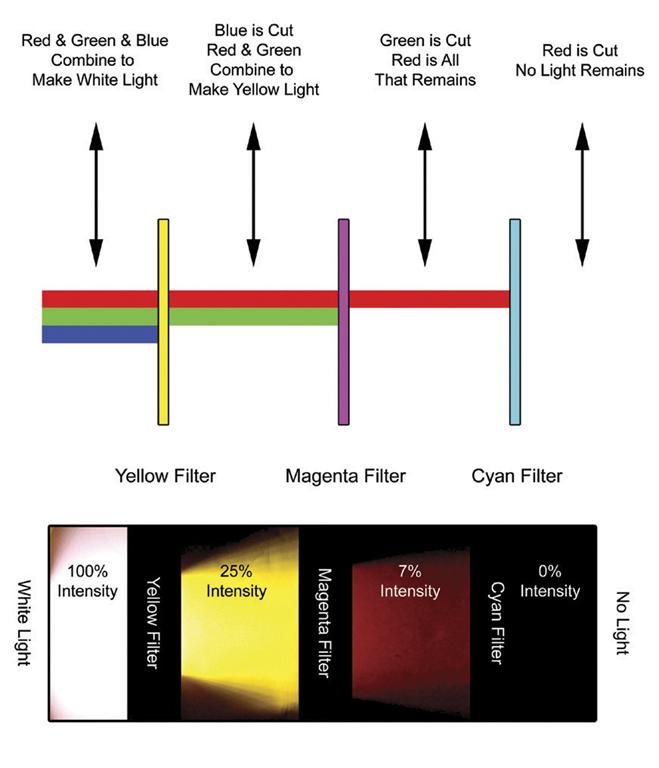Additive and Subtractive Color Mixing

Jay Holben
Recently I was asked to lecture at a college for a course in advanced cinematography. The professor asked that I include color theory in my lecture and at first, I was a little overwhelmed at the concept. Color theory could fill an entire curriculum in and of itself, yet I only had a scant three hours to speak, and that was to be just one of the topics.
I asked the professor for more detail on what he’d like to have covered and why. He told me that some of his students were having trouble grasping the idea of colored light and the way it interacts with colored sets and costumes. Ah! OK! So I can cover an introduction to additive and subtractive color mixing and help clear up that concept a bit. Since that’s still fresh in my mind, it shall be our adventure this month.

Fig. 1: Additive color mixing, such as light, has different primaries. Subjective color mixing is what happens when you mix paint pigments together.
SEEING THE LIGHT
We cannot see light. This is a concept that generally provokes quizzical stares from my lecture attendees, but it’s a hard fact of the physics of our world. We cannot see the wavelengths (or particles) of light traveling through space.
What we can see, is light reflecting or refracting off of objects in our world. You don’t see the light falling on the page as you read this; you see the light reflecting off the surface of the page to reach your eye. Some people argue that they can see light beams in the air, but we only see light beams because that light is refracted through something in the air; be that dust, moisture or smoke.
The professional video industry's #1 source for news, trends and product and tech information. Sign up below.
What our eyes see is the reflection of light off of objects, and that light reflecting off the object is altered by the object itself. Every object in our world reflects a certain amount of light, but it also absorbs a certain amount. The colors you see are based on wavelengths of light reflecting off of the object, while others are absorbed.
We see a basketball as orange because the pigments in the leather of that ball are rejecting (reflecting) off certain yellow, orange and red wavelengths of light while absorbing green, blue, indigo and violet.

Fig. 2: Red, green and blue light are mixed together. You can see the secondaries and white at the center. The natural source of light in our world is the sun. The sun, as an incandescent source—that is light from heat—projects light waves in all sizes so that light from the sun contains all of the colors of the visible spectrum: red, orange, yellow, green, blue, indigo and violet (like Pluto, Indigo was downgraded some time ago as not an “official” part of the spectrum; but I still include him for old time’s sake).
Under normal circumstances, all of these wavelengths of light strike all the objects in our world that are lit by the sun. Each object absorbs some wavelengths and reflects others. If we deprive that particular object of the wavelengths of light that it rejects, we will significantly alter the appearance of that object.
This is also a hard concept to grasp because humans have wonderful color memory. If I take a strawberry, which we all know is red, and I put it in a dark room and light it with light that contains no red wavelengths, the strawberry will appear blackish. Most people look at that and say “it’s just dark.” But the truth is the colors aren’t there to reflect back to our eyes and cameras don’t have this wonderful color memory. They only record the truth.
SUBTRACTIVE AND ADDITIVE
There are two different physics of color mixing: subtractive and additive, (see Fig. 1). Subtractive color mixing is what happens when you mix paint pigments together. For anyone who ever took art classes as a kid, you were taught the primary colors were red, yellow and blue. I’m here to tell you that’s an outright lie. I think they teach kids this because magenta and cyan are difficult words to grasp at an early age. The pigment primaries are magenta (not red), cyan (not blue) and yellow (they got that one right).

Fig. 3: Subtractive color mixing and the results using yellow, magenta and cyan filters. When you mix pigment colors together, every addition of a new color darkens your result. In subtractive mixing, every addition of a new color brings the result closer to black. The combination of all colors is black and the absence of color is white.
Additive color mixing, such as light, has different primaries. We deal with red, green and blue. If you keep in mind that every addition of a light source makes the result brighter, it’s easier to grasp that as you add colors in additive mixing, you get closer to white. White light is the combination of all colors and black is the absence of light.
The two physics of color work together. When you mix pigment primaries (also called secondaries), you get the lighting primary colors. Mix cyan and magenta together to get blue. Mix yellow and cyan together to get green. Mix yellow and magenta together to get red. When you mix enough equal parts of yellow, cyan and magenta, you get black.
Likewise, if you’re using the primary colors of light, you can mix red and green to get yellow (remember in additive, the result is brighter than the two colors you’re mixing); you can mix green and blue together to get cyan and you can mix blue and red together to get magenta. When you combine red, green and blue together, you get white.
Figs. 2 and 3 are two actual photographs I took looking at real-world physics of color in action. Fig. 2 uses red, green and blue light mixed together and you can see the secondaries and a close approximation of white at the center. My sources weren’t the most pure sources so the color mix isn’t perfect, but it’s definitely a real-world example.
Fig. 3 shows subtractive color mixing using colored gels. Gels are subtractive because they stop certain wavelengths of light from passing through. In essence, they absorb those colors and allow others to pass through. So we start with white light (red, green and blue) and pass that through a yellow filter. The yellow stops the blue and lets red and green pass through. The result is yellow light (red and green light combined make yellow).

Fig. 4: In example A, the strawberry is displayed using a white light. In B, it is displayed using a cyan filter, which stops the red from passing through. Note that the intensity of the light is reduced because we’re filtering out some of the wavelengths, so we’re down to 25 percent original intensity now. When we put a magenta filter in front of that, it stops the green light, but allows the red to pass through.
Now we only have red light—and it’s 7 percent of the original intensity because we’ve filtered out all the other wavelengths. Finally we put a cyan filter in the path of the red light and the result is zero-percent intensity. The cyan filter doesn’t allow the red to pass through, so we have no light on the other side.
Where this intertwines is when we realize that we only see objects in our world as their colors because they are reflecting those wavelengths back to our eyes. So if we go back to the example of the strawberry and we light it with white light, we’ll see that beautiful red, (see Fig. 4), but if we put a cyan filter in front of the light source that stops red light from reaching the strawberry, it will no longer be receiving the red to reflect it back and will appear nearly black. (There are other wavelengths of light mixed in with the red, so not pure black.)
You have to keep the principles of both additive and subtractive color mixing in mind when you’re lighting a set. The colors of the walls, set, props, products, etc., are all biased by the colors (and integrity of color) of your light sources.
One student at the school had a set that was painted all brown and they wanted a moonlight feel with blue light and were confused when the walls became black in their image. The walls were black because the blue light didn’t contain the red and yellow that the walls wanted to reflect, so they went black.
This whole topic is further complicated by white balance and picking your white point, which biases the way the camera sees colors even further, but that’s a subject for another day.
Jay Holben is the technical editor of Digital Video and a contributor to Government Video. He is also the author of the book “A Shot in the Dark: A Crative DIY Guide to Digital Video Lighting on (Almost) No Budget.”
